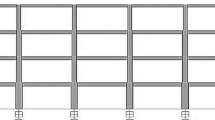Abstract
In this paper, the rotational behavior of asymmetric base-isolated buildings is compared with the similar asymmetric fixed-base buildings. A vast range of lead rubber bearings with different periods is considered to evaluate the effect of the isolation degree on seismic responses of the structures. The simulation results confirm that the base isolators are able to reduce rotation of stories. However, this reduction is negligible in large eccentricities. The numerical simulations show that increasing period of isolators results in large displacement at bearings located on the flexible edge of the isolation system. This paper proposes practical solutions to reduce torsional responses of the base-isolated structures. In order to investigate the effectiveness of the proposed solutions, four structural models are defined. Considering three earthquake excitations, the simulation results of these models indicate that increase in stiffness of flexible edge of isolation system can reduce torsional responses of asymmetric 3-story base isolated structure. Furthermore, the simultaneous increase in stiffness of flexible edge of isolation system and superstructure lead to a suitable reduction of torsional responses in asymmetric 8-story base-isolated structure.
Similar content being viewed by others
References
Computers and Structures Inc. (1999). ETABS: Three dimensional analysis and design of building systems, Berkeley, California, USA.
De Stefano, M. and Pintucchi, B. (2008). “A review of research on seismic behavior of irregular building structures since 2002.” Bulletin of Earthquake Engineering, Vol. 6, No. 2, pp. 285–308, DOI: 10.1007/s10518-007-9052-3.
Eisenberger, M. and Rutenberg, A. (1986). “Seismic base isolation of asymmetric shear buildings.” Engineering Structures, Vol. 8, No. 1, pp. 2–8, DOI: 10.1016/0141-0296(86)90013-1.
Etedali, S., Sohrabi, M. R., and Tavakoli, S. (2013). “Optimal PD/PID control of smart base isolated buildings equipped with piezoelectric friction dampers.” Earthquake Engineering and Engineering Vibration, Vol. 12, No. 1, pp. 39–54, DOI: 10.1007/s11803-013-0150-8.International Code Council, Uniform Building Code (UBC), USA, 1997.
Jangid, R. S. and Datta, T. K. (1994a). “Nonlinear response of torsional coupled base isolated structure.” Journal of Structural Engineering, Vol. 120, No. 1, pp. 1–22, DOI: 10.1061/(ASCE) 0733-9445(1994) 120:1(1).
Jangid, R. S. and Datta, T. K. (1994b). “Seismic response of torsionally coupled structures with elastoplastic base isolation.” Engineering Structures, Vol. 16, No. 4, pp. 256–262, DOI: 10.1016/0141-0296 (94)90065-5.
Khoshnudian, F.,and Imani Azad, A. (2011). “Effect of two horizontal components of earthquake on nonlinear response of torsionally coupled base isolated structures.” The Structural Design of Tall and Special Buildings, Vol. 20, No. 8, pp. 986–1018, DOI: 10.1002/ tal.571.
Khoshnudian, F. and Motamedi, D. (2014). “Seismic response of asymmetric steel isolated structures considering vertical component of earthquakes.” KSCE Journal of Civil Engineering, Vol. 17, No. 6, pp. 1333–1347, DOI: 10.1007/s12205-013-0115-5.
Kilar, V. and Koren, D. (2009). “Seismic behaviour of asymmetric base isolated sructures with various distributions of isolators.” Engineering Structures, Vol. 31, No. 4, pp. 910–921. DOI: 10.1016/j.engstruct. 2008.12.006.
Kilar, K., Petrovèiè, S., Koren, D., and Šilih, S. (2011). “Seismic analysis of an asymmetric fixed base and base-isolated high-rack steel structure.” Engineering Structures, Vol. 33, No. 12, pp. 3471–3482, DOI: 10.1016/j.engstruct.2011.07.010.
Lee, D. M. (1980). “Base isolation for torsion reduction in asymmetric structures under earthquake loading.” Earthquake Engineering and Structural Dynamics, Vol. 8, No. 4, pp. 349–359, DOI: 10.1002/ eqe.4290080405.
Naeim, F. and Kelly, J. M. (1999). Design of seismic isolated structures from theory to practice, John Wiley & Sons, Inc.
Nagarajaiah, S., Reinhorn, A. M., and Constantinou, M. C. (1991). 3DBasis: Nonlinear dynamic analysis of three dimensional base isolated structures Part II, Technical report NCEER-91-0005. National Center for Earthquake Engineering, State University of New York, Buffalo.
Nagarajaiah, A. M., Reinhorn, A. M., and Constantinou, M. C. (1993). “Torsion in base isolated structures with elastomeric isolation systems.” Journal of Structural Engineering, Vol. 119, No. 10, pp. 2932–2951, DOI: http://dx.doi.org/10.1061/(ASCE)0733-9445(1993)119:10(2932).
Ryan, K. L. and Chopra, A. K. (2004). “Estimation of seismic demands on isolators in asymmetric buildings using non-linear analysis.” Earthquake Engineering & Structural Dynamics, Vol. 33, No. 3, pp. 395–418, DOI: 10.1002/eqe.358.
Seguin, C. E., De la Llera, J. C., and Almazán, J. L. (2008). “Basestructure interaction of linearly isolated structures with lateraltorsional coupling.” Engineering Structures, Vol. 30, No. 1, pp. 110- 125, DOI: 10.1016/j.engstruct.2007.02.019.
Seguin, C. E., Almazán, J. L., and De la Llera, J. C. (2013). “Torsional balance of seismically isolated asymmetric structures.” Engineering Structures, Vol. 46, pp. 703–717, DOI: 10.1016/j.engstruct.2012.08.025.
Su, A. L., Ahmadi, G., and Tadjbakhsh, I. G. (1989). “A comparative study of performance of various base-isolation system, part I: Shear beam structures.” Earthquake Engineering & Structural Dynamics, Vol. 18, No. 1, pp.11–32, DOI: 10.1002/eqe.4290180104.
Tena-Colunga, A. and Zambrana-Rojas, C. (2006). “Dynamic torsional amplifications of base-isolated structures with an eccentric isolation system.” Engineering Structures, Vol. 28, No. 1, pp. 72–83, DOI: 10.1016/j.engstruct.2005.07.003.
Tena-Colunga, A. and Escamilla-Cruz, J. L. (2007) “Torsional amplifications in asymmetric base-isolated structures.” Engineering Structures, Vol. 29, No. 2, pp. 237–247, DOI: 10.1016/j.engstruct.2006.03.036.
Wolff, E. D., Ipek, C., Constantinou, M. C., and Morillas, L. (2014). “Torsional response of seismically isolated structures revisited.” Engineering Structures, Vol. 59, pp. 462–468, DOI: 10.1016/ j.engstruct.2013.11.017.
Author information
Authors and Affiliations
Corresponding author
Rights and permissions
About this article
Cite this article
Etedali, S., Sohrabi, M.R. A proposed approach to mitigate the torsional amplifications of asymmetric base-isolated buildings during earthquakes. KSCE J Civ Eng 20, 768–776 (2016). https://doi.org/10.1007/s12205-015-0325-0
Received:
Revised:
Accepted:
Published:
Issue Date:
DOI: https://doi.org/10.1007/s12205-015-0325-0




